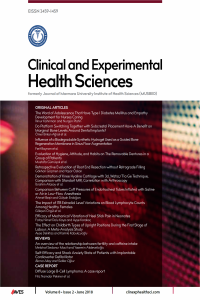Sinüs Tabanı Ogmentasyonunda, Polietilen Glikol Hidrojel Membran Kullanımı ve Kollajen Membran ile Kıyaslanması
Abstract
References
- Block MS, Kent JN. Maxillary sinus grafting for totally and partially edentulous patients. J Am Dent Assoc. 1993;124(5):139-43
Influence of a Biodegradable Synthetic Hydrogel Used as a Guided Bone Regeneration Membrane in Sinus Floor Augmentation
Abstract
Objective: The purpose of this study is to compare the clinical, histological,
and radiological aspects of the polyethylene glycol (PEG) hydrogel membrane
and the standard collagen membrane in sinus floor augmentation
procedures when the same bone filling material is used.
Methods: Fourteen patients (5 men and 9 women) were included in this
prospective cohort study. Twenty sinus floor augmentation surgeries were
randomly divided into two groups: the study group (n=10) and the control
group (n=10). An anorganic bovine graft (Bio-Oss®, Geistlich Pharma
AG, Switzerland) was used in all patients as the bone-filling material. As
a protective membrane, a collagen membrane (Bio-Gide®, Geistlich Pharma
AG, Switzerland) was used in the control group patients, as well as a
PEG membrane (Membragel®, Institut Straumann AG, Switzerland) in the
study group. After 6 months, the samples were collected during implant
site preparation for histopathological evaluation.
Results: There were no statistically significant differences between the
control and the study groups in the histological examination regarding
the soft-to-hard tissue ratio. There was no statistically significant difference
between the control and study groups in the resonance frequency analysis
measurements at different times. No postoperative inflammation or
exposure of the membrane was observed in any of the patients. The visual
analogue scale scores measured at different times also showed no significant
difference.
Conclusion: A PEG membrane can be used as an alternative to a collagen
membrane as a barrier in sinus floor augmentation procedures.
References
- Block MS, Kent JN. Maxillary sinus grafting for totally and partially edentulous patients. J Am Dent Assoc. 1993;124(5):139-43
Details
| Primary Language | English |
|---|---|
| Journal Section | Articles |
| Authors | |
| Publication Date | June 15, 2018 |
| Submission Date | May 9, 2017 |
| Published in Issue | Year 2018 Volume: 8 Issue: 2 |


